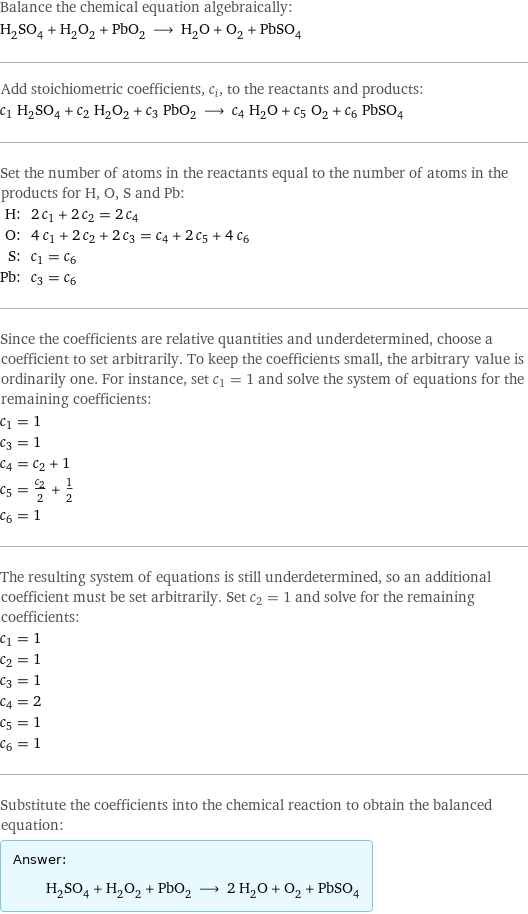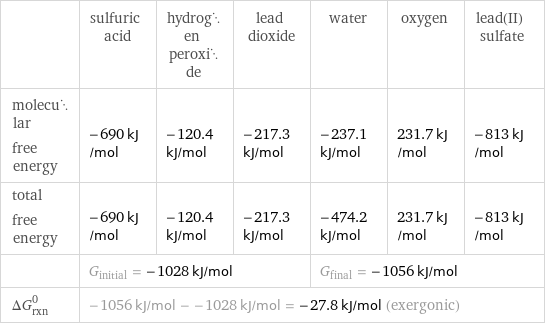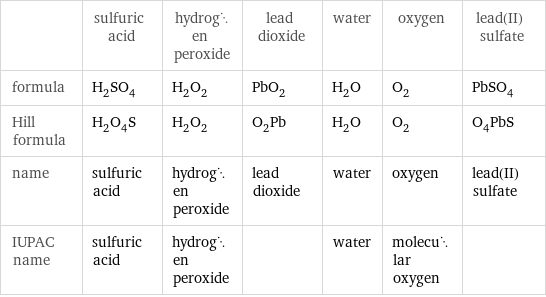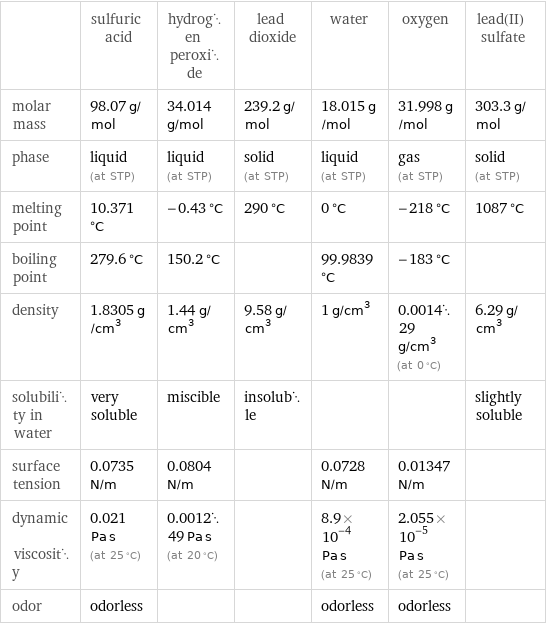Input interpretation

H_2SO_4 sulfuric acid + H_2O_2 hydrogen peroxide + PbO_2 lead dioxide ⟶ H_2O water + O_2 oxygen + PbSO_4 lead(II) sulfate
Balanced equation

Balance the chemical equation algebraically: H_2SO_4 + H_2O_2 + PbO_2 ⟶ H_2O + O_2 + PbSO_4 Add stoichiometric coefficients, c_i, to the reactants and products: c_1 H_2SO_4 + c_2 H_2O_2 + c_3 PbO_2 ⟶ c_4 H_2O + c_5 O_2 + c_6 PbSO_4 Set the number of atoms in the reactants equal to the number of atoms in the products for H, O, S and Pb: H: | 2 c_1 + 2 c_2 = 2 c_4 O: | 4 c_1 + 2 c_2 + 2 c_3 = c_4 + 2 c_5 + 4 c_6 S: | c_1 = c_6 Pb: | c_3 = c_6 Since the coefficients are relative quantities and underdetermined, choose a coefficient to set arbitrarily. To keep the coefficients small, the arbitrary value is ordinarily one. For instance, set c_1 = 1 and solve the system of equations for the remaining coefficients: c_1 = 1 c_3 = 1 c_4 = c_2 + 1 c_5 = c_2/2 + 1/2 c_6 = 1 The resulting system of equations is still underdetermined, so an additional coefficient must be set arbitrarily. Set c_2 = 1 and solve for the remaining coefficients: c_1 = 1 c_2 = 1 c_3 = 1 c_4 = 2 c_5 = 1 c_6 = 1 Substitute the coefficients into the chemical reaction to obtain the balanced equation: Answer: | | H_2SO_4 + H_2O_2 + PbO_2 ⟶ 2 H_2O + O_2 + PbSO_4
Structures

+ + ⟶ + +
Names

sulfuric acid + hydrogen peroxide + lead dioxide ⟶ water + oxygen + lead(II) sulfate
Reaction thermodynamics
Gibbs free energy

| sulfuric acid | hydrogen peroxide | lead dioxide | water | oxygen | lead(II) sulfate molecular free energy | -690 kJ/mol | -120.4 kJ/mol | -217.3 kJ/mol | -237.1 kJ/mol | 231.7 kJ/mol | -813 kJ/mol total free energy | -690 kJ/mol | -120.4 kJ/mol | -217.3 kJ/mol | -474.2 kJ/mol | 231.7 kJ/mol | -813 kJ/mol | G_initial = -1028 kJ/mol | | | G_final = -1056 kJ/mol | | ΔG_rxn^0 | -1056 kJ/mol - -1028 kJ/mol = -27.8 kJ/mol (exergonic) | | | | |
Equilibrium constant
![Construct the equilibrium constant, K, expression for: H_2SO_4 + H_2O_2 + PbO_2 ⟶ H_2O + O_2 + PbSO_4 Plan: • Balance the chemical equation. • Determine the stoichiometric numbers. • Assemble the activity expression for each chemical species. • Use the activity expressions to build the equilibrium constant expression. Write the balanced chemical equation: H_2SO_4 + H_2O_2 + PbO_2 ⟶ 2 H_2O + O_2 + PbSO_4 Assign stoichiometric numbers, ν_i, using the stoichiometric coefficients, c_i, from the balanced chemical equation in the following manner: ν_i = -c_i for reactants and ν_i = c_i for products: chemical species | c_i | ν_i H_2SO_4 | 1 | -1 H_2O_2 | 1 | -1 PbO_2 | 1 | -1 H_2O | 2 | 2 O_2 | 1 | 1 PbSO_4 | 1 | 1 Assemble the activity expressions accounting for the state of matter and ν_i: chemical species | c_i | ν_i | activity expression H_2SO_4 | 1 | -1 | ([H2SO4])^(-1) H_2O_2 | 1 | -1 | ([H2O2])^(-1) PbO_2 | 1 | -1 | ([PbO2])^(-1) H_2O | 2 | 2 | ([H2O])^2 O_2 | 1 | 1 | [O2] PbSO_4 | 1 | 1 | [PbSO4] The equilibrium constant symbol in the concentration basis is: K_c Mulitply the activity expressions to arrive at the K_c expression: Answer: | | K_c = ([H2SO4])^(-1) ([H2O2])^(-1) ([PbO2])^(-1) ([H2O])^2 [O2] [PbSO4] = (([H2O])^2 [O2] [PbSO4])/([H2SO4] [H2O2] [PbO2])](../image_source/2050ec33ff7a393dda628ceac6b0a08f.png)
Construct the equilibrium constant, K, expression for: H_2SO_4 + H_2O_2 + PbO_2 ⟶ H_2O + O_2 + PbSO_4 Plan: • Balance the chemical equation. • Determine the stoichiometric numbers. • Assemble the activity expression for each chemical species. • Use the activity expressions to build the equilibrium constant expression. Write the balanced chemical equation: H_2SO_4 + H_2O_2 + PbO_2 ⟶ 2 H_2O + O_2 + PbSO_4 Assign stoichiometric numbers, ν_i, using the stoichiometric coefficients, c_i, from the balanced chemical equation in the following manner: ν_i = -c_i for reactants and ν_i = c_i for products: chemical species | c_i | ν_i H_2SO_4 | 1 | -1 H_2O_2 | 1 | -1 PbO_2 | 1 | -1 H_2O | 2 | 2 O_2 | 1 | 1 PbSO_4 | 1 | 1 Assemble the activity expressions accounting for the state of matter and ν_i: chemical species | c_i | ν_i | activity expression H_2SO_4 | 1 | -1 | ([H2SO4])^(-1) H_2O_2 | 1 | -1 | ([H2O2])^(-1) PbO_2 | 1 | -1 | ([PbO2])^(-1) H_2O | 2 | 2 | ([H2O])^2 O_2 | 1 | 1 | [O2] PbSO_4 | 1 | 1 | [PbSO4] The equilibrium constant symbol in the concentration basis is: K_c Mulitply the activity expressions to arrive at the K_c expression: Answer: | | K_c = ([H2SO4])^(-1) ([H2O2])^(-1) ([PbO2])^(-1) ([H2O])^2 [O2] [PbSO4] = (([H2O])^2 [O2] [PbSO4])/([H2SO4] [H2O2] [PbO2])
Rate of reaction
![Construct the rate of reaction expression for: H_2SO_4 + H_2O_2 + PbO_2 ⟶ H_2O + O_2 + PbSO_4 Plan: • Balance the chemical equation. • Determine the stoichiometric numbers. • Assemble the rate term for each chemical species. • Write the rate of reaction expression. Write the balanced chemical equation: H_2SO_4 + H_2O_2 + PbO_2 ⟶ 2 H_2O + O_2 + PbSO_4 Assign stoichiometric numbers, ν_i, using the stoichiometric coefficients, c_i, from the balanced chemical equation in the following manner: ν_i = -c_i for reactants and ν_i = c_i for products: chemical species | c_i | ν_i H_2SO_4 | 1 | -1 H_2O_2 | 1 | -1 PbO_2 | 1 | -1 H_2O | 2 | 2 O_2 | 1 | 1 PbSO_4 | 1 | 1 The rate term for each chemical species, B_i, is 1/ν_i(Δ[B_i])/(Δt) where [B_i] is the amount concentration and t is time: chemical species | c_i | ν_i | rate term H_2SO_4 | 1 | -1 | -(Δ[H2SO4])/(Δt) H_2O_2 | 1 | -1 | -(Δ[H2O2])/(Δt) PbO_2 | 1 | -1 | -(Δ[PbO2])/(Δt) H_2O | 2 | 2 | 1/2 (Δ[H2O])/(Δt) O_2 | 1 | 1 | (Δ[O2])/(Δt) PbSO_4 | 1 | 1 | (Δ[PbSO4])/(Δt) (for infinitesimal rate of change, replace Δ with d) Set the rate terms equal to each other to arrive at the rate expression: Answer: | | rate = -(Δ[H2SO4])/(Δt) = -(Δ[H2O2])/(Δt) = -(Δ[PbO2])/(Δt) = 1/2 (Δ[H2O])/(Δt) = (Δ[O2])/(Δt) = (Δ[PbSO4])/(Δt) (assuming constant volume and no accumulation of intermediates or side products)](../image_source/dabc7a8245c98d7b438cc3e18a625e47.png)
Construct the rate of reaction expression for: H_2SO_4 + H_2O_2 + PbO_2 ⟶ H_2O + O_2 + PbSO_4 Plan: • Balance the chemical equation. • Determine the stoichiometric numbers. • Assemble the rate term for each chemical species. • Write the rate of reaction expression. Write the balanced chemical equation: H_2SO_4 + H_2O_2 + PbO_2 ⟶ 2 H_2O + O_2 + PbSO_4 Assign stoichiometric numbers, ν_i, using the stoichiometric coefficients, c_i, from the balanced chemical equation in the following manner: ν_i = -c_i for reactants and ν_i = c_i for products: chemical species | c_i | ν_i H_2SO_4 | 1 | -1 H_2O_2 | 1 | -1 PbO_2 | 1 | -1 H_2O | 2 | 2 O_2 | 1 | 1 PbSO_4 | 1 | 1 The rate term for each chemical species, B_i, is 1/ν_i(Δ[B_i])/(Δt) where [B_i] is the amount concentration and t is time: chemical species | c_i | ν_i | rate term H_2SO_4 | 1 | -1 | -(Δ[H2SO4])/(Δt) H_2O_2 | 1 | -1 | -(Δ[H2O2])/(Δt) PbO_2 | 1 | -1 | -(Δ[PbO2])/(Δt) H_2O | 2 | 2 | 1/2 (Δ[H2O])/(Δt) O_2 | 1 | 1 | (Δ[O2])/(Δt) PbSO_4 | 1 | 1 | (Δ[PbSO4])/(Δt) (for infinitesimal rate of change, replace Δ with d) Set the rate terms equal to each other to arrive at the rate expression: Answer: | | rate = -(Δ[H2SO4])/(Δt) = -(Δ[H2O2])/(Δt) = -(Δ[PbO2])/(Δt) = 1/2 (Δ[H2O])/(Δt) = (Δ[O2])/(Δt) = (Δ[PbSO4])/(Δt) (assuming constant volume and no accumulation of intermediates or side products)
Chemical names and formulas

| sulfuric acid | hydrogen peroxide | lead dioxide | water | oxygen | lead(II) sulfate formula | H_2SO_4 | H_2O_2 | PbO_2 | H_2O | O_2 | PbSO_4 Hill formula | H_2O_4S | H_2O_2 | O_2Pb | H_2O | O_2 | O_4PbS name | sulfuric acid | hydrogen peroxide | lead dioxide | water | oxygen | lead(II) sulfate IUPAC name | sulfuric acid | hydrogen peroxide | | water | molecular oxygen |
Substance properties

| sulfuric acid | hydrogen peroxide | lead dioxide | water | oxygen | lead(II) sulfate molar mass | 98.07 g/mol | 34.014 g/mol | 239.2 g/mol | 18.015 g/mol | 31.998 g/mol | 303.3 g/mol phase | liquid (at STP) | liquid (at STP) | solid (at STP) | liquid (at STP) | gas (at STP) | solid (at STP) melting point | 10.371 °C | -0.43 °C | 290 °C | 0 °C | -218 °C | 1087 °C boiling point | 279.6 °C | 150.2 °C | | 99.9839 °C | -183 °C | density | 1.8305 g/cm^3 | 1.44 g/cm^3 | 9.58 g/cm^3 | 1 g/cm^3 | 0.001429 g/cm^3 (at 0 °C) | 6.29 g/cm^3 solubility in water | very soluble | miscible | insoluble | | | slightly soluble surface tension | 0.0735 N/m | 0.0804 N/m | | 0.0728 N/m | 0.01347 N/m | dynamic viscosity | 0.021 Pa s (at 25 °C) | 0.001249 Pa s (at 20 °C) | | 8.9×10^-4 Pa s (at 25 °C) | 2.055×10^-5 Pa s (at 25 °C) | odor | odorless | | | odorless | odorless |
Units
